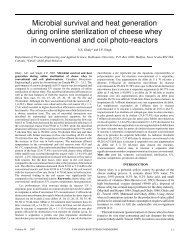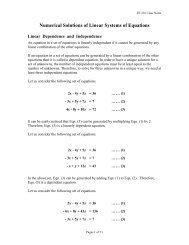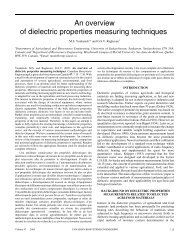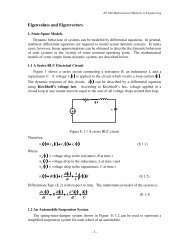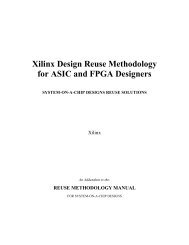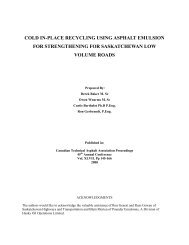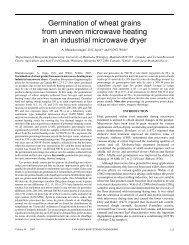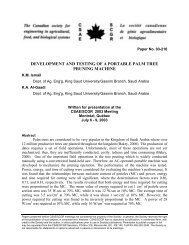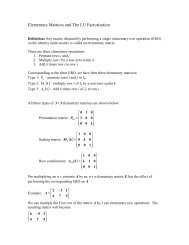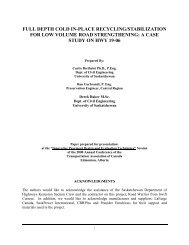Cold in Place Rock Crushing and Stabilization of Northern Low ...
Cold in Place Rock Crushing and Stabilization of Northern Low ...
Cold in Place Rock Crushing and Stabilization of Northern Low ...
You also want an ePaper? Increase the reach of your titles
YUMPU automatically turns print PDFs into web optimized ePapers that Google loves.
Berthelot, Gerbr<strong>and</strong>t, Safronetz, <strong>and</strong> Sparks. Page: 73 TEST SECTION DESIGN, LAYOUT, AND CONSTRUCTIONThe test sections constructed on SDHT Hwy 918-01were designed <strong>and</strong> constructed around the objective toevaluate the effectiveness <strong>of</strong> crush<strong>in</strong>g protrud<strong>in</strong>g boulders <strong>in</strong>-place, <strong>and</strong> stabiliz<strong>in</strong>g the <strong>in</strong> situ gravel road s<strong>and</strong> subgrade.The stabilizers considered <strong>in</strong> this study <strong>in</strong>cluded low plastic clay, calcium chloride, DL10 Special asphalt emulsion, <strong>and</strong>SS-1 asphalt emulsion. The <strong>in</strong>-place rock crush<strong>in</strong>g <strong>and</strong> stabilization test sections constructed as part <strong>of</strong> the Highway918-01 test site <strong>in</strong>clude:a) In-place rock crush<strong>in</strong>g, reshap<strong>in</strong>g, <strong>and</strong> recompaction with no stabilization (control section).b) In-place rock crush<strong>in</strong>g, reshap<strong>in</strong>g, recompaction <strong>and</strong> surface modification with low plastic clay.c) In-place rock crush<strong>in</strong>g, reshap<strong>in</strong>g, recompaction <strong>and</strong> stabilization/modification with calcium chloride.d) In-place rock crush<strong>in</strong>g, reshap<strong>in</strong>g, recompaction <strong>and</strong> stabilization/modification with low plastic clay <strong>and</strong>calcium chloride.e) In-place rock crush<strong>in</strong>g, reshap<strong>in</strong>g, recompaction <strong>and</strong> stabilization with DL-10 asphalt emulsion.f) In-place rock crush<strong>in</strong>g, reshap<strong>in</strong>g, recompaction <strong>and</strong> stabilization with SS-1 asphalt emulsion.Stabilizer concentrations <strong>and</strong> layer thicknesses were based on the characterization results <strong>of</strong> the subgrade <strong>and</strong>the properties <strong>of</strong> the alternative stabilizers/modifiers considered <strong>in</strong> this study. The stabilized test sections aresummarized <strong>in</strong> Table 2. As seen <strong>in</strong> Table 2, the asphalt emulsion stabilized test sections considered <strong>in</strong> this study<strong>in</strong>cluded the addition <strong>of</strong> DL10 Special <strong>and</strong> SS-1 at concentrations <strong>of</strong> 2.5, 4.5 <strong>and</strong> 6.5 percent. Given a residual asphaltcement content <strong>of</strong> approximately 60 percent, the residual asphalt cement content <strong>in</strong> the field was 1.5, 2.7 <strong>and</strong> 3.9 percentby dry weight <strong>of</strong> soil respectively. Table 3 summarizes <strong>and</strong> Figure 6 illustrates the Marshall stability after a seven-daycure <strong>and</strong> the reta<strong>in</strong>ed Marshall stability after a seven-day cure <strong>and</strong> a 48 hour soak <strong>of</strong> each SDHT Hwy 918-01 stabilizedmaterial system. Marshall stability was chosen as the relative measure <strong>of</strong> stability because it is commonly understood<strong>and</strong> well referenced. As also seen <strong>in</strong> Table 3 <strong>and</strong> Figure 6, the Marshall stability <strong>of</strong> the Highway 918 subgrade soil wassignificantly improved with the addition <strong>of</strong> asphalt emulsion whereas the addition <strong>of</strong> the calcium chloride <strong>and</strong> clay onlymarg<strong>in</strong>ally <strong>in</strong>creased Marshall stability. When soaked for 48 hours, the reta<strong>in</strong>ed stability <strong>of</strong> the unmodified Highway918 subgrade <strong>and</strong> that <strong>of</strong> the Highway 918 subgrade with clay <strong>and</strong>/or calcium chloride modification was negligible.However, the reta<strong>in</strong>ed stability <strong>of</strong> the Highway 918 subgrade modified with asphalt emulsion was found to be onlyslightly less than that observed from the unsoaked samples, illustrat<strong>in</strong>g the moisture resistance <strong>of</strong> the asphalt emulsionstabilized soil.



